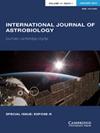Early taphonomic processes in a microbial-based sedimentary system from a temperate salt-pan site (Cervia salterns, Italy)
IF 1
4区 物理与天体物理
Q3 ASTRONOMY & ASTROPHYSICS
引用次数: 3
Abstract
Abstract In the only salt evaporation pond retaining its natural setting of the historic Salina di Cervia (Italy), the northernmost salterns of the Mediterranean area, a number of potentially preservable textures derive from the interactions between photosynthetic mat producers and the sedimentary substrate. These morphologies occur at the beginning of the taphonomic processes when repeated emerged-submerged conditions take place. In these conditions the cohesive nature of the diatom- and cyanobacterial-derived mucilage favours the stabilization of otherwise ephemeral structures. Surface micromorphologies for which diatoms and cyanobacteria have played some active role when still living in the soft microlayer and down to the sediment-water interface, such as during the gliding motility, can overcome the surface layer of most intense mixing (i.e., the taphonomically active zone) and keep traces of them in the fossil record either as body fossils or as texture contributors. Tiny microbial-derived remnants, such as filaments and biofilm strands of halotolerant microorganisms, while fragile upon their formation, can therefore stabilize as biosignatures when combined with salt precipitation. Halophilic and halotolerant ecosystems are models for life in extreme environments (analogue sites) with similarity to those strongly suspected to occur and/or have occurred on Mars and on other planetary bodies. The study of hypersaline systems such as Salina di Cervia which harbour diverse and abundant microbial life, can be relevant for astrobiology since it allows the investigation of potential biosignatures and their preservation, and of further understand the range of conditions and the planetary processes sustaining potentially habitable systems.温带盐田遗址(Cervia salterns,意大利)微生物沉积体系的早期埋藏学过程
在地中海地区最北端的盐沼——意大利历史悠久的Cervia盐沼(Salina di Cervia),唯一保留其自然环境的盐蒸发池中,许多潜在的可保存纹理来自光合作用席生产者和沉积基质之间的相互作用。这些形态发生在埋藏过程的开始,当反复出现的淹没条件发生时。在这些条件下,硅藻和蓝藻衍生的黏液的凝聚力有利于稳定其他短暂的结构。硅藻和蓝藻在生活在软质微层及沉积物-水界面时,如在滑动运动期间,对表面微形态发挥了积极作用,它们可以克服最强烈混合的表层(即埋藏活跃带),并作为体化石或纹理贡献物在化石记录中留下痕迹。微生物衍生的微小残留物,如耐盐微生物的细丝和生物膜链,虽然在形成时很脆弱,但当与盐沉淀结合时,可以作为生物特征稳定下来。嗜盐和耐盐生态系统是极端环境(模拟地点)中的生命模式,与强烈怀疑在火星和其他行星上可能发生和/或已经发生的生命模式相似。研究高盐系统,如Salina di Cervia,它拥有多样化和丰富的微生物生命,可以与天体生物学相关,因为它允许调查潜在的生物特征及其保存,并进一步了解维持潜在宜居系统的条件范围和行星过程。
本文章由计算机程序翻译,如有差异,请以英文原文为准。
求助全文
约1分钟内获得全文
求助全文
来源期刊

International Journal of Astrobiology
地学天文-地球科学综合
CiteScore
3.70
自引率
11.80%
发文量
45
审稿时长
>12 weeks
期刊介绍:
International Journal of Astrobiology is the peer-reviewed forum for practitioners in this exciting interdisciplinary field. Coverage includes cosmic prebiotic chemistry, planetary evolution, the search for planetary systems and habitable zones, extremophile biology and experimental simulation of extraterrestrial environments, Mars as an abode of life, life detection in our solar system and beyond, the search for extraterrestrial intelligence, the history of the science of astrobiology, as well as societal and educational aspects of astrobiology. Occasionally an issue of the journal is devoted to the keynote plenary research papers from an international meeting. A notable feature of the journal is the global distribution of its authors.
 求助内容:
求助内容: 应助结果提醒方式:
应助结果提醒方式:


